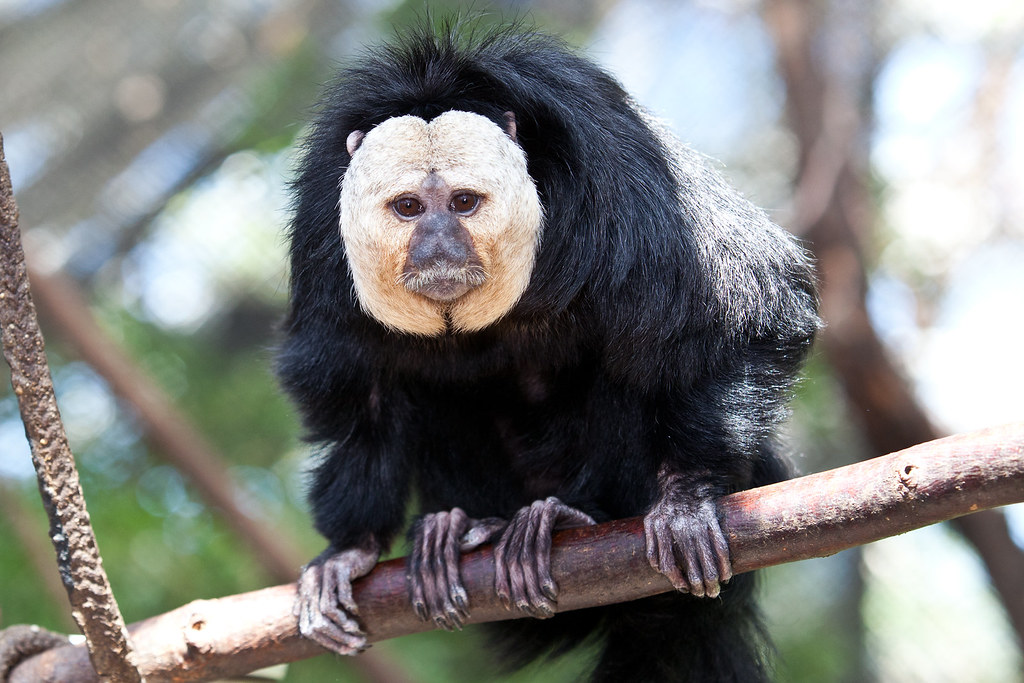The White-faced Saki is a New World monkey found in rainforests throughout the northeast region of South America in northern Brazil, French Guiana, Suriname, Guyana, and Venezuela. They are usually found in the lower-to-mid canopy of the forest. These monkeys are generalists who can adapt to both wet and dry conditions in a variety of altitudes with relative ease. The White-faced Saki is also called the Guianan Saki and the Golden-faced Saki. Interestingly, if a predator is near, alarm calls, which have been observed to last from 1.2 to 88 minutes, will be sounded by an initial saki and then continually echoed by others to spread the warning. They will then puff their bodies up and stomp their feet on the ground or trees in an attempt to intimidate the threat. Read on to learn more about these smart sakis.
Features Of The White-faced Saki
- Sexual dimorphism: White-faced sakis display noticeable sexual dimorphism in their coloration and also in size.
- Female Hair: Females have shorter hair than males, with brownish-grey fur and white or pale brown stripes around the corners of the nose and mouth. Females have less hairs surrounding their eyes and snout.
- Male Hair: Males, on the other hand, have blacker fur, with a reddish-white forehead, face, and throat. Male white-faced sakis have the signature white face. Their faces are much whiter than females and males are larger in body size.
- Weight: Males are approximately 500 grams heavier than females. Studies show the male white-faced saki weighs between 4 and 5.2 lb (1.8–2.4 kg), while the female’s weight ranges 3 to 4.1 lb (1.35–1.89 kg).
- Length: Both sexes have similar body length of 12.5 to 16 in (32–40 cm), with tails usually matching their body length.
- Tail & Nose: The tail is bushy and non-prehensile. These unique-looking monkeys also have characteristically flat noses.
- Fingers: Their long, skinny fingers and toes have thick pads on the tips to give them a better grip on branches. The wide separation between the thumb and index finger allows them to climb up thick branches and trunks with ease.
- Young: Young saki males are often identified as females because of their sometimes “grizzling” dorsal hair and orangish bellies and it is approximately 2 months of age when males and females being to show differences, although it gradually becomes obvious over a few years.
Scientific Classification Of The White-faced Saki
White-faced Saki – Pithecia Pithecia [Scientific name]
- Kingdom: Animalia
- Phylum: Chordata
- Class: Mammalia
- Order: Primates
- Suborder: Haplorhini
- Infraorder: Simiiformes
- Family: Pitheciidae
- Genus: Pithecia
- Species: P. pithecia
Reproduction Of The White-faced Saki
In captivity, the female white-faced sakis experience ovarian cycles of approximately 17 days, and a gestational period of 20–21 weeks. Following birth, the mother undergoes a period of lactationally-induced infertility lasting 23 weeks, on average. White-faced sakis breed once a year (in the spring) and only have one offspring. They typically live around 14 years in their natural habitat and have been recorded to live up to 36 years in captivity. Also, they are active in the day and sleep highly elevated (15-20m) in trees with many leaves to shelter them from weather and flying predators.
Saki Groups & Travel: A South American study performed by Shawn M. Lehman shows that their group number can range from 2-12 group members, with higher numbers typically occurring (but not exclusively) in Guyana, South America. But most widespread observations conclude that they travel in small groups of 2 and 3 which usually include the bonded parents and the offspring; they travel approximately 0.5 to 1.25 miles in search of food or other resources during the early morning and day, when they are most active.
Tip: A pair often mates for life, and they are very devoted to one another. They will strengthen their bond by grooming one another. Male saki monkeys are usually more active than females.
Diet Of The White-faced Saki
White-faced sakis prefer trees that produce high amounts of fruit, Capparis trees, and trees with water holes. They rely on fruits and seeds for roughly 90% of their diet. They have thick and strong teeth designed to crush seed shells and peel away at fruit. However, they do have a mixed diet of seeds, fruits, leaves, honey, flowers, insects, and small mammals and birds and typically ingest seeds and plants that are high in lipid composition. They have also been observed crawling into hollow portions of trees and eating bats where they roost. They are capable of doing so due to their large canine teeth which assist in cracking the hard-outer covering of shells and nuts.
Did You Know? In the face of danger, white faced sakis will emit warning calls to others or freeze if in the canopy in an attempt to move down where they are out of sight. For example, if there is a smaller, easily overpowered threat, the group will participate in a behavior called “mobbing” to scare the predator away, but if the threat is larger, such as an eagle, they will refrain from warning calls and descend out of sight into the lower canopy.
White-faced Saki In Guyana
Yes, these monkeys are fascinating creatures. The adult males are also avid scent markers, marking their territory using combinations of urine and their gular gland near their throat. 92% of all scent markings are made by adult males. Males tend to mark trees rich in fruit, which other sakis are more likely to visit. Additionally, the saki is a primarily arboreal monkey, spending almost their entire life in the trees. Hence, they are nicknamed “flying monkeys” for their exceptional ability to leap from tree to tree. We are privileged to have these tree-dwellers in Guyana!
Article References:
- https://en.wikipedia.org/wiki/White-faced_saki
- https://www.neprimateconservancy.org/white-faced-saki.html
- Main Image: https://live.staticflickr.com
Discover more from Things Guyana
Subscribe to get the latest posts sent to your email.







